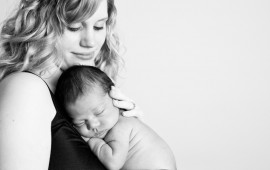5 Body Changes to Expect After Birth
Author: Shannon Miller Lifestyle

If you’re expecting a baby shortly, no doubt you’re preparing for your new arrival.
However, besides getting your home ready and stocking up with the supplies you’ll need for your newborn, are you ready for the changes you will experience after birth? You’ve probably got a good idea of what life will be like with a new baby, but being aware of the changes your body is likely to go through is also important. You know you aren’t going to return to your pre-pregnancy body in a hurry, but understanding some of the changes that are in store for you means that when they do happen, it won’t come as a shock.
Bleeding
While you’ve had some respite from your monthly bleed during pregnancy, don’t forget that it’s normal to bleed for up to 6 weeks after birth. This bleeding, known as lochia, is heaviest in the first 10 days, after which the discharge gradually lessens; though if you try to do too much exercise, blood loss increases. You’ll also notice that the blood changes in color from bright red at first through to pink, brown and then a yellow-white discharge. To absorb the blood, maternity pads are preferable to regular sanitary pads, as the chemicals used in many sanitary pads irritate your skin following birth; tampons are also inadvisable for the first 6 weeks after delivery, as their use may introduce an infection to your uterus. While clots are not uncommon, particularly large clots or heavy bleeding is a signal to get in touch with your doctor.
Hemorrhoids
If you avoided hemorrhoids during pregnancy by including plenty of fiber and fluids in your diet to prevent constipation, you might think that you don’t need to worry about this painful problem. However, if you have a vaginal delivery, they may develop during labor due to the pressure put on the veins in the rectum. If you do develop hemorrhoids, a warm bath, medicated wipes or placing baking soda on the affected area may offer relief. Hemorrhoids that last more than a fortnight or those that bleed should always be checked out by a doctor though.
Urinary incontinence
Whether you have a vaginal delivery or c-section, you may experience temporary urinary incontinence. This occurs when nerves supplying the bladder are damaged, leading to numbness, which makes it difficult to know when you need to visit the bathroom and you may struggle to control the muscles that regulate the flow of urine. The problem is not helped by the fact that your pelvic floor muscles (those that support your uterus, bladder and bowel) stretch during pregnancy and birth. Although this is an embarrassing problem for women, in most cases the nerves recover in a matter of months and daily pelvic floor exercises help to tone the muscles that control urination. Until this happens you might be tempted to drink less, but if you breastfeed it’s particularly important to drink plenty and restricting your fluid intake also increases the risks of urinary tract infections. Therefore drink at least 8 glasses of decaffeinated fluids daily; tea, coffee, cola and other drinks that contain caffeine are best avoided, as these tend to irritate the bladder.
Loss of abdominal tone
If you expect your pre-pregnancy stomach to return shortly after birth, the reality is that most women they still look pregnant several months after having their baby. It’s important to remember that after 9 months of stretching your uterus isn’t going to return to normal immediately and typically takes around 6 weeks to resume its usual size and shape. However, your stomach will take longer than this, possibly a year, to reach its pre-pregnancy appearance and even then some women they are still left with a post-pregnancy belly. This is partly because hormonal changes encourage fat to deposit around the abdominal area, but also because your abdominal muscles become looser. Exercise may help tone these muscles, but don’t be tempted by low-calorie diets in the months after birth, as if breastfeeding this can interfere with the quality of breast milk, not to mention leaving you extremely tired. Equally don’t be tempted by supplements promising to tone you, as these often are not backed by scientific evidence and the safety of muscle bulking agents is questionable, frequently bringing with them a range of short-term and long-term health problems. No matter what you think of your post-pregnancy stomach, remember that your body did something amazing and the important thing is that both you and your baby are healthy.
Hair loss
You may notice that during pregnancy your hair has become fuller and shinier, which probably came as a nice surprise. This is down to raised levels of estrogen in pregnancy, which causes a greater proportion of your hairs to grow at any one time and fewer to shed. However, after delivery your hair won’t stay this way, as falling estrogen levels cause reduced growth and greater hair shedding, which is usually most noticeable around four months after giving birth. While you may feel conscious of this and wonder whether your hair will ever return to normal, the good news is that this change to your hair isn’t permanent; most women find that their hair returns to full thickness within a year. There’s not that much you can do to prevent hair loss as a consequence of hormonal changes, but avoiding harsh brushing, hair dryers, straighteners and hair dyes may help to reduce hair loss. Ensuring that you consume a balanced diet will also make sure your growing hairs have the nutrients they need for good growth and try a volumizing shampoo and conditioner or a new hairstyle to make your hair look thicker.
